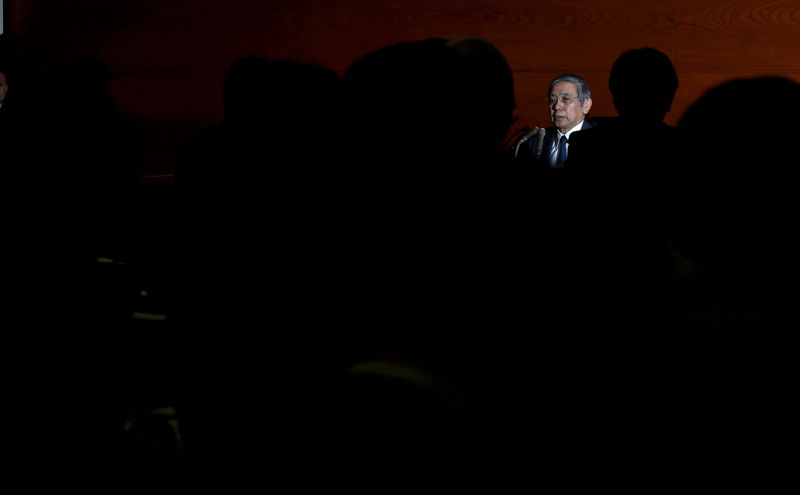 © Reuters. FILE PHOTO: BOJ Governor Kuroda attends a news conference at the bank’s headquarters in Tokyo
© Reuters. FILE PHOTO: BOJ Governor Kuroda attends a news conference at the bank’s headquarters in TokyoBy Leika Kihara and Tetsushi Kajimoto
TOKYO (Reuters) – Japan’s central bank chief said on Tuesday a future exit from ultra-easy monetary policy would need to be “very gradual”, in comments analysts described as a bid to temper expectations about a near-term end to crisis-mode stimulus.
Bank of Japan Governor Haruhiko Kuroda startled markets last week when he told lawmakers that the central bank could consider exiting easy policy if his inflation target was met in fiscal 2019 as projected, remarks that sent the yen and bond yields higher.
Speaking in parliament again on Tuesday, he said the BOJ had the necessary tools to engineer a smooth exit from easy policy and was already brainstorming how a future stimulus exit could affect its balance sheet, but sounded caution about withdrawing too quickly.
“When the BOJ exits, it will be a very gradual process … so as not to trigger a spike in long-term interest rates or a disruption in financial markets,” Kuroda said on Tuesday.
“We need to move cautiously so as not to hurt the economy and prices,” he said, adding that details on when and how to exit will depend on economic and price conditions at the time.
Kuroda stressed that an actual exit from easy policy was some time away with inflation, now at 0.9 percent, still distant from his 2 percent target.
“Underlying price moves remain weak, so our feeling is that there is some distance to achieving our price target,” Kuroda said. “It’s unthinkable to end or weaken the degree of monetary easing before our inflation target is met.”
Kuroda appeared before the upper house of parliament for confirmation hearings after the government reappointed him to serve another five-year term when the current one ends in April.
It is a near certainty parliament will approve the government’s nomination because premier Shinzo Abe’s ruling coalition holds a majority in both houses of parliament.
“Kuroda sounded confident about an exit probably out of need to reassure market the BOJ can engineer a smooth exit when the appropriate time comes,” said Masaki Kuwahara, senior economist at Nomura Securities.
“I think the BOJ will stand pat at least until fiscal 2020 given tepid inflation.”
TONING DOWN
In reference to his comments last week, Kuroda on Tuesday said they weren’t intended to give an explicit timeframe for an actual exit.
“I didn’t say the BOJ will immediately exit the easy policy in fiscal 2019. I only said there could be some debate of an exit if inflation hits 2 percent during fiscal 2019, as we project,” Kuroda said.
Under the current forecast, the BOJ’s nine-member board projects inflation to reach 2 percent during the fiscal year ending in March 2020. Many analysts see the estimate as too ambitious in a country barely emerging from deflation.
“People reacted strongly to Kuroda’s comments about the exit last week, so I think he was trying to tone this down today,” said Shuji Tonouchi, senior market economist at Mitsubishi UFJ Morgan Stanley (NYSE:) Securities.
“The outlook for prices could weaken a little, making it difficult for the BOJ to move policy.”
Japan’s economy has been recovering steadily but inflation remains well below the BOJ’s target, as companies hold off on raising prices for fear of scaring away cost-sensitive consumers.
Years of heavy money printing to reflate growth have hurt already thin margins of Japan’s financial institutions, drawing calls from lawmakers for the BOJ to be more mindful of the cost of prolonged monetary easing.
Kuroda said he did not see any serious threats to Japan’s banking system. But he said the BOJ would “obviously” debate an exit strategy from easy policy when its price target is met.
“There are various means to exit,” such as mopping up liquidity via market operations and raising the interest the BOJ pays to excess reserves financial institutions park at the central bank, Kuroda said.
“The BOJ is also doing some brainstorming” on how a future exit could affect its balance sheet, though how and through what means it would withdraw stimulus would depend on economic and price conditions at the time, he said.
Source: Investing.com




























